May 11, 2004
[Posted on May 13, 2004] [Minor correction: May 19, 2004]
Editor's
Note (Toru Nakagawa, May 11, 2004)
This is a personal report of TRIZCON2004 held two weeks ago in Seattle. (See Altshuller Institute's Official Web site.) About 85 people attended at the conference and presented/discussed a wide range of TRIZ research and applications. Here I am trying to personally review the presentations/papers of the Conference and to post it publicly. Please remember that the description here is my personal view reflecting my impression and may have any possiblity of misunderstanding and biases whatever efforts I made to understand them fully and faithfully. I know that any presentation/paper/event may have different relevance and give different impression to any other people. Nevertheless, this kind of report should be helpful for many people in the world to understand current progress and future directions of TRIZ, I hope. If you find any mistake/misunderstanding in this report, please let me know via email. (You may also be interested in referring to my previous reports of TRIZCON2003and ETRIACON2003
.)
In a separate page, I have posted my own paper prepresented at TRIZCON entitled a "Practices of Applying TRIZ/USIT in Japan"(at moment in English; in a few weeks in Japanese as well) . I also wish to repost some of the TRIZCON2004 papers here in near future with the courtesy of authors both in English and in Japanese translation.
Conference Name:
TRIZCON2004: The 6th Annual Conference of
the Altshuller Institute for TRIZ Studies
Date:
April 25-27, 2004
Place:
Westin Hotel Seattle, Seattle, WA, USA
Held by:
Altshuller Institute for TRIZ Studies, Inc.
(USA)
Supported by:
Ideation International Inc., Invention
Machine Inc., Ford Motor Co., Boeing, The TRIZ Journal, QualSoft,
Technical
Innovation Center.
Participants:
about 85 people from 9 countries
Outline
of the
Agenda: Tutorial: 2 tracks from 8:00 to 17:00
on
April 25 (Sunday)
Symposium: 1 Keynote Speech and 1 Panel Discussion at
plenary
sessions, 19 presentations in double tracks, from 8:30 through 17:30 on
April 26 (Monday) and April 27 (Tuesday).
Agenda: (In the order of actual presentation. The number in [ ] stands for the paper number in the Proceedings (or handouts). See the table of contents of the Proceedings at the bottom of this report. *: attended at by Nakagawa. )
Tutorial
| Apr.
25 (Sun.) Morning |
Introduction
to TRIZ Ellen Domb and Joe Miller |
A Unified Approach to System Resolving
Conflicts Victor Fey |
| Maximizing Utilization of New Solutions
-- Super
Effects Zinovy Royzen |
||
| Afternoon | Advanced Topics on Substance-Field
Modeling Sergei Ikovenko |
Symposium
| Apr.
26 (Mon.) Morning |
Opening (Opening Address by Larry Smith) | |
| Panel
Discussion: "The Implementation of TRIZ in the Corporate World"
Jack Hipple (Coordinator); Larry Smith, John Spitznagel, Kiho Sohn, Doug Gundlach, Adam Brostow [B] * |
||
| TRIZ Patterns of
Evolution
and Industrial Design N. Leon [13] * |
Enhancing SWOT
Analysis
Using TRIZ R. King [4] |
|
| Levels of
Invention and
Intellectual Property Strategies Boris Zlotin, Alla Zusman [10]* |
Innovation in the
Material
Cost of 8 mm Camcorder Using TRIZ Y-H. Cho [24] |
|
| TRIZ Success
Stories Simon Litvin [31]* |
TRIZ through the
Eyes of
the Chief Technology Officer P. Hanik and D. Bonner [32] |
|
| Afternoon |
Practices of
Applying TRIZ/USIT
in Japan T. Nakagawa [17]* |
Tour of Boeing's Assembly Plant in Everett |
| TRIZ and System
Dynamics
Model of a Revitalization Project J. Miller [27] * |
||
| Process Modeling,
Simulation
and TRIZ: A Symbiotic Solution C. Sorgie [19] |
||
| Evening | Cocktail Hour | |
| Apr.
27 (Tue.) Morning |
Keynote
Speech: TRIZ and Innovation at BAE Systems P. Marsh [A]* |
|
| Strategies for
Patent Busting S. Ikovenko [33]* |
Integration of
TRIZ, QFD
and Six Sigma M. Slocum, E. Domb [2] |
|
| TRIZ Management
Problems
Solved at BAE Systems K. Gadd, P. Marsh [34]* |
TRIZ Activities
in Samsung
Electronics S.-W. Kang [25] * |
|
| Afternoon | TRIZ in Samsung R
&
D Process M.J. Song [3] * |
TRIZ and AI Software in Conceptual
Design T. Tiidemann [29] |
| TRIZ and Future
Vision B. Zlotin, A. Zusman [35] * |
Cooling Problem
of Wire
Rod H.G. Yoon [22] |
|
| TRIZ Thinking
about Thinking
about Thinking G. Rawlinson [1] * |
Semantic
TRIZ J. Todhunter [30]* |
|
| Concluding Remarks (Larry Smith) | ||
Overview:
This
is the 6th TRIZ Conference
annually held by the Altshuller Institute. The Altshuller
Institute
for TRIZ Studies is a not-for-profit organization established in
USA
in 1998 for wider promotion of TRIZ in the Western world (See its Web
site:
http://www.aitriz.org/
). The Conference, named TRIZCON, has been held at different
cities:
Novi (near Detroit) in 1999 ,
Nashua (near Boston) in 2000
,
Woodland Hills (near Los
Angeles) in 2001
, St. Louis in 2002, Philadelphia
in 2003
,
and Seattle this time. Details of the organizing work was carried
mostly by Mr. Richard Langevin, Executive Director of the Institute.
The total number of participants was about 85 according to the list of participants. Participants came from the following 9 countries (according to my counting, with minor uncertainties): USA (67), Korea (7), UK (3), Canada (2), China (2), Mexico (1), Austria (1), Estonia (1), and Japan (1). This list includes 26 people sent especially from Boeing.
On the first day, Tutorial sessions were held in two parallel tracks, one for introductory, and the other for advanced topics. About 60 people attended at these tutorials. The tutorials must be helpful for the participants to learn the basic concepts of TRIZ and some advanced topics of TRIZ from masters of TRIZ. They are not reviewed here, however, as I did not attend them.
The second and the third days are for Symposium. The schedule was similar to the previous ones. Keynote speech and Panel Discussion were scheduled for 90 minutes in plenary sessions, while ordinary presentations for 60 minutes in two-track parallel sessions. (On Monday afternoon, one-track presentations were parallel to the bus tour to Boeing's assembly plant in the suburbs of Seattle.) Most sessions finished about 10 minutes earlier than the time table, giving much time for private discussions.
The Proceedings contain 18 papers (though one of them is just an abstract) in about 290 pages, while 14 papers of them were actually presented. 3 other presentations were provided with handouts. Keynote Speech, Panel Discussion, and 2 more presentations did not provide any printed material. All the papars/presentations are listed at the bottom of this report and are cited here in their number in [ ]. Altshuller Institute's Journal "Izobretenia", Vol. 5, was also published and handed to the participants.
Topics of the presentations
cover a wide range, while the sessions seem not arranged in any clear
categorization.
In this report I am going to group them in the following categories:
(A) Promotion of TRIZ in
Industries: Keynote Speech, Panel
Discussion, and Presentations
(B) Methods
of Applying TRIZ to Technology Problems
(C) Case
Studies of Solving Technicla Problems in TRIZ
(D) Applicaton of
TRIZ to Business, Management, and Human Problems
I am going
to review almost
all the papers below. However, since I attended only half
of
the presentations (due to the parallel sessions) and read all the
papers
only after the conference, please pardon me if I do not understand some
of them in their heart.
(A) Promotion of TRIZ in Industries: Keynote Speech, Panel Discussion, and Presentations
One of the main topics of the Conference this year is how to promote TRIZ in industries. Several success stories were presented in Keynote Speech (in UK), Panel Discussion (mostly in USA), and presentations (in USA, Korea, Japan, and India).
In the Keynote Speech, Pauline Marsh
(BAE Systems, UK) [A] talked
about her experiences with the title of "TRIZ and Innovation at BAE Systems",
saying: She learned about TRIZ in a seminar in 1999 and
immediately started to introduce it in her department,
Customer Suppor & Solutions, International, where she served as
Chief Engineer. She put much stress on the training in TRIZ and
application of it to real problems, with the help of external
consultants. In three months she was already giving a TRIZ
training course serving as the instructor for herself. In 5
years, 500 engineers were already trained
in
BAE Systems. Especially in her department having about 100
people, TRIZ is already a common language because most of them were
trained in TRIZ and are regularly using it. However, 500 is still
just a scratch of the 10,000 engineers in BAE Systems. In case of
a mid business with one business unit, a methodology like TRIZ can be
promoted smoothly in combination of the bottom-up and top-down
promotions. In big businesses with multiple business units (like
BAE Systems), such promotion takes much more time to spread into other
business units. For overcoming this, 5-module TRIZ courses are
currently operated with the support of a consulting firm in UK.
The TRIZ ways of thinking are mostly taught, while TRIZ software tool
is taught only at the fifth module of the course. An intranet
TRIZ Web site is operated for sharing problems and experiences in TRIZ,
and regular meetings of TRIZ champions of different sections are
held.
-- This speech presented a nice successful
case of penetration of TRIZ in a big industry. She says TRIZ in
her company already has a strong system of promotion to develop by
itself, but still needs time to get the critical mass in the whole
company.
Presentation by Karen Gadd (Oxford Creativity, UK) and Pauline Marsh (BAE Systems, UK) [34] reports some more detail about their promotion activities in BAE Systems, where Karen Gadd served as the consultant. In one of her slide, Karen Gadd reports as:
"Since 1999 I have been teaching TRIZ in BAE Systems and around 2001 I knew I'd made a breakthrough and seen the way forward.She says "It is important that Management learn and use TRIZ."
I was rung one morning by a group of engineers who were ecstatic. As they made their way to their office they heard their engineering director who had just returned from his first TRIZ course. He was talking to a group about a new project -- and he was saying "Lets start by establishing what we want, define our Ideal Final Result, and then we'll assess the resources and look at the contradictions."
They said he was speaking our language, using the same tools as us and after just two days of TRIZ, an enthusiastic convert. He went on to do the full five days and has used TRIZ on several major problems and produced solutions which are now being approved by the Secretary of State."
Panel Discussion
was held
in the first session of the Symposium part of the Conference with the
coordination
by Jack
Hipple, with the theme "The
Implementation of TRIZ in the
Corporate World". In the introduction, the coordinator
showed his
concern about the current situation of TRIZ: " In USA much interests in
TRIZ occurred but faded, and early big industrial users never
came
to share their findings with us. What should we do to make TRIZ
active
in industries?" A variety of observations of difficulties
and
trials of activities were mentioned by the panelists and
participants.
(Sorry but it is difficult for me to summarize the discussions. A
summary will probably be made by the Coordinator, I am told.)
Jack
Hipple pointed out: "People are too busy for solving wrong problems".
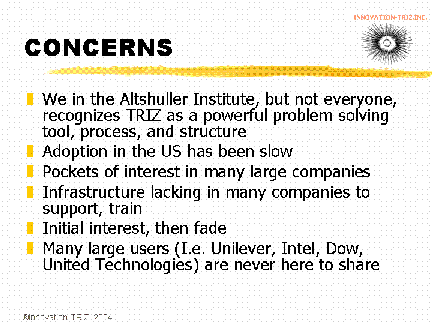
[This slide is inserted here with
the courtesy of Jack Hipple. (May 19, 2004 TN)]
Nearly at the end of the discussion Nakagawa argued: "So far we have been talking that difficulties come from outside of TRIZ (e.g. industrial culture is wrong), but I think the core part of the difficulty lies inside TRIZ as well. Similar to all technical systems, TRIZ has been developed to become more and more complex, and it is now faced with the contradiction of difficulty to learn and to apply because of its complexity. Thus now it is the time to evolve TRIZ further to make it easy to learn and apply by simplifying and unifying it, just as the evolution theory of TRIZ tells us."
Presentation by Simon Litvin (GEN3 Partners, USA) [31] is a success story from a big consulting firm based in USA and having a huge network of researchers world wide. He is currently Vice President of 'GEN3 Partners', which recently merged Pragmatic Vision Inc. which was a big consulting firm spun out of Invention Machine Corp. The consulting firm has about 30 employees in USA, over 100 employees in Russia and nearby countries, and has a network of about 7000 professional researchers and engineers on the contract basis all over the world (mostly Russia, Belarus, Israel, etc.). When they tackle contract research projects, they first analyze the problem in an employee team to find generalized function to be required and to find a leading technology area for such a function. Then on their world-wide network, they invite best experts in such a field to join the team (virtually throuhg the network) and to try to solve the original problem by suitably adopting/modifying the expertise. The author calls their approach as "TRIZ++: Professional Team Approach" and illustrates their philosophy in the following figure:
The initial problem: to design a better nasal filter for preventing allergies.This approach seems simple and powerful. For us ordinary engineers, software tools of function knowledge bases may be useful in place of the huge network of professionals in this approach.
Key problem: high effectiveness in filtering but low breathing resistance.
Initial function of requirement: to trap pollens from inhaled air.
Generalized function: to separate particles from a gas flow, without a filtering medium.Initial technology area: medical devices, respirators.
Leading technology area for the generalized function: industrial dust collectors.
Best experts of the leading technology area: Negev-Tornado in Israel. --- (Thus invited to join the team.)Best technology: Industrial cyclones
Action principle: Centrifugal separation, rather than filtering medium.
New problem statement: How can we adapt the cyclone to the nostrils?
-- What, other than fans, drive air flow?
-- How could small particles be trapped?
Solution:
Health Breath Filter (to be inserted in the nostrils)
Action principle:
Vortex chamber with custom inlet geometry,
Sticky walls,
Breathing drives the air flowResults:
95 % effectiveness for particles > 5 micro m.
Low breathing resistance
Low cost -- $2 per dozen pairs
Presentation by Peter Hanik and David Bonner (Ideation International) [32] also represents an approach in USA. (Since I did not attend the presentation and no handout was available, I cannot review it here.)
Presentations by Sun-Wook Kang et
al. (Samsung
Electronics, Korea) [25]
and by Mi-Jeong
Song et al. (Samsung Advanced
Institute of Technology (SAIT), Korea) [3] were most impressive for
me
as the best practice and success story for promoting TRIZ in a big
industry.
It is a pity that the papers in the Proceedings are rather short in the
case of [25] or only an
abstract in the case of [3];
we would be happy if
the authors and their companies could publish the full presentations in
some form. The two presentations report slightly different but
essentially
the same approach operated in different parts of Samsung group.
In the
background in Korea around
1997, there
was a grass-root TRIZ study group of pioneering engineers coming from
different
companies such as LG Electronics, Samsung, etc. In 1997 LG
Electronics
started to invite TRIZ specialists for seminars and employed a TRIZ
specialist
from Belarus to solve a number of projects in the joint team of the
TRIZ
specialist and Korean employees and to install TRIZ training.
Since
the trial in LG was a big success, Samsung started similar TRIZ project
teams by inviting TRIZ specialists.
Samsung
started their TRIZ project teams in SAIT in 1999 and in Samsung
Electronics in 2001 with the leadership
of the top management. Currently Samsung group employs about 10
TRIZ
specialists from Belarus, Russia, Ukraine, etc. and has already
implemented
a powerful system of applying and training TRIZ in their R&D
activities.
They have formed Samsung TRIZ Association (STA) for cooperative
promotion
and training of TRIZ in the Samsung group companies. The on-line
TRIZ training system in SAIT was presented in ETRIA TRIZ Conference in
2002 by Nikolai Shpakovsky et
al. [See ]
The following figure (Fig. 1 of [25])
shows their scheme of implementing
TRIZ in Samsung. The roles of
the invited TRIZ specialists and of ordinary employees are described
here
in a progressive manner in the Beginning Stage and then in the
(current)
Regular Stage. Problem solving projects in TRIZ and training in
TRIZ
are regarded as the two essential activities operated in parallel.
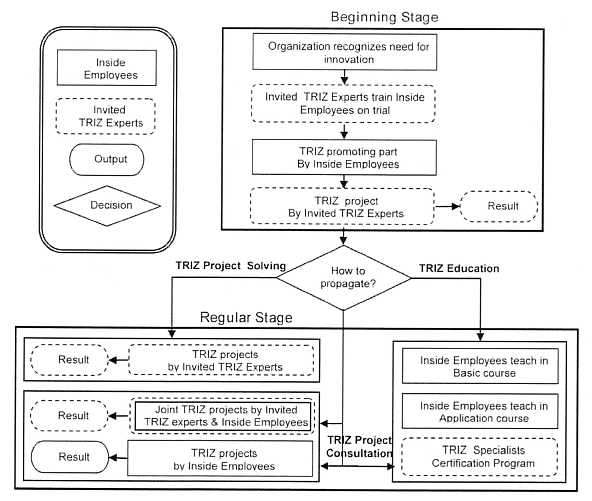
The TRIZ training in Samsung Electronics
contains:
Basic Course (40 hrs) + Application Course (40 hrs) + TRIZ Specialist
Course
(40 hrs class + 4 month project). This training has already
generated
48 TRIZ Specialists in Samsung Electronics alone.
Problem solving process in TRIZ is integrated in the more general Six Sigma process which has been promoted company wide. The scheme is summairzed in the figure shown below (Fig. 3 of [25]). As presented in the case study report [24] (see below) various TRIZ methods for analyzing and solving problems seem to be used on the basis of so much training. More than 100 projects were solved with TRIZ in Samsung Electronics in 2003, and a brief table of topics of representative projects in various divisions was shown in the presentation -- it was really amazing.
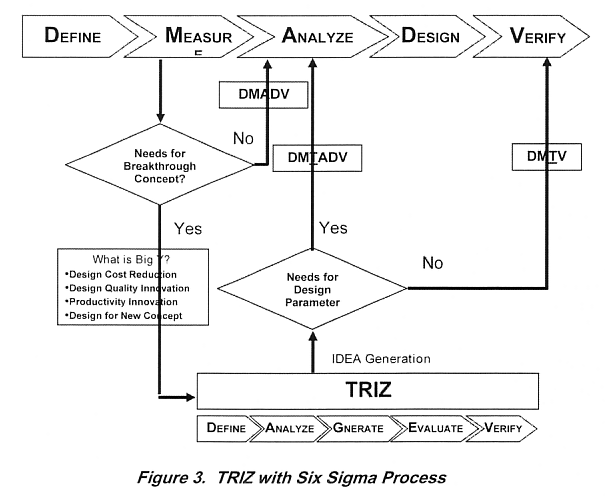
The
present author, Toru Nakagawa [17] presented
a paper with the title of "Practices
of Applying TRIZ/USIT in Japan".
Activities of promoting TRIZ in Japan are reviewed in the context of
three
strategies. (A) The initial prevailing (and still prevailing in
some parts of the world) strategy is to introduce
the whole TRIZ in its original Russian form, with the support by
software
tools, and in a top-down manner. In 1999, Nakagawa proposed (B)
the
"Slow-but-Steady Strategy", and then reflecting the progress of general
understanding of TRIZ he recently proosed (C) the "Steady
Strategy".
The strategy (C) recommends to understand the essence (in contrast to
its
details) of TRIZ, to apply USIT process as a simple and unified
way
of problem solving in TRIZ with the support of software tools as
knowledge bases, and to encourage/authorize/enhance voluntary TRIZ
groups
to apply TRIZ to real industrial problems. In Japan there are
three
typical TRIZ approaches, including Mitsubishi & Invention Machine's
software-based approach, SANNO & Ideation International's
theory-based
approach, and Nakagawa's USIT-process approach.
TRIZ
activities in
various Japanese companies are briefly reviewed on the basis of their
public presentations
mostly done at Japan IM User Group Meetings. Fuji Xerox, Ricoh,
Fuji Photo
Film, and Nissan are typical cases where TRIZ has been implemented
gradually
with grass-root activities for these 7 years or so. All the three
approaches have been used mostly in parallel and USIT has actually been
applied to
real projects in these comapnies. Hitachi and Panasonic
Comminications
are the cases where TRIZ has been promoted in a more systematic,
top-down
manner together with QFD and Taguchi Method. Having these cases
of
successful promotion/application of TRIZ, Japan seems to have reached
the
beginning of a new era of TRIZ penetration where the "Steady Strategy"
has its practical basis. Please see more detail in the paper
reposted in
this Web site "TRIZ Home Page in Japan".
Paper by Prakash Apte,
S.Soman (Indian Inst. of Tech. Bombay, India) and Darrell Mann
(CREAX, UK) [16] is an
interesting report of teaching TRIZ
to undergraduate engineering students. For 12
undergraduate students of electrical and mechanical departments of IIT
Bombay, the authors gave 5 lectures of 2 hrs each with one week
intervals. The 1st lecture was the overview of TRIZ
methodology. At the 2nd lecture, Physical Contradiction and
Separation Princiles were taught with simple everyday life
examples. Then forming 2-member teams, real technical problems
were assigned in the field of MEMS (Micro-Electro-Mechanical Systems)
as home works. Then three more lectures were given on Technical
Contradictions and Contradiction Matrix, on S-Field Model for
eliminating harmful effects, and on Trends of Evolution and Ideal Final
Result. In parallel to these lectures the progress of students'
home works were discussed together. The three lectures (3rd to
5th) were intended to teach different aspects of TRIZ methods which can
support the problem solving mostly done along the Separation
Principles. All the student teams generated various, novel
solutions. They (together with Professor Apte) submitted and
presented academic papers at various international conferences; even
one of them received a Best-Paper Award, the authors say.
Known solutions in up-to-date patents were used as
the initial problem from which Physical Contradictons were
extracted. The following figure (Fig. 2 of [16]) illustrates one of their
problem and their solution. This mirror should be flexible for
deflecting light in different directions; however it is easily broken
during transportation and setting. The solution is to attach thin
rods for supporting the mirror during manufacturing and setting, and to
fuse them away after setting up.
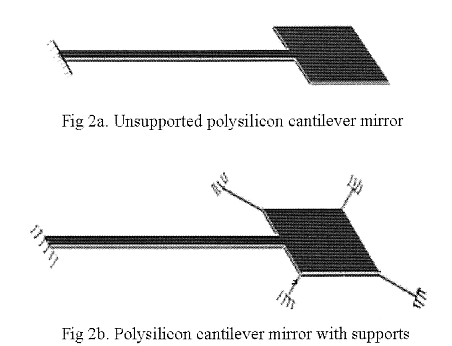
This
project is a remarkable experiment, I agree. There should be a
number of keys for success. First, the problems given were the
real (unsolved) ones in the field of the instructor (Professor
Apte). This point is supposed to be valuable to guide
students to meaningful directions (even though the instructor does not
show any solution). Second, the selection (and arrangement) of
TRIZ tools must be the key. Derivation of Physical Contradictions
was apparently done in a straight forward way on the basis of
analogy to everyday life examples. We notice that these
keys are usually obtainable in R&D activities in engineering
industries.
(B) Methods of Applying TRIZ to Technology Problems
Boris Zlotin and Alla Zusman (Ideation International, USA) [10] talked about "Levels of Invention and Intellectual Property Strategies". It was a nice instructive presentation. On the basis of statistical analysis of a large number of patents, they recommend the following strategies: For low-level of inventions, you should not neglect possibilities of growth of their applications. (Historical examples may include the invention of an oil lamp in 1840 just before the invention of kerosene (in 1855) and oil wells (in 1859). Kerosene lamps increased "bright time", which is equal to the increase in man power by 25-30 percent, and later induced the inventions of electric lamps (and the whole use of electricity), oil industries (and the whole inventions of petrolium chemistry), combustion engines (and automobile industries), etc.) For higher level inventions, you should be aware of their long implementation time and hence you should try to identify lower-level applications of them for short-term investment returns and to identify consequent problems at lower levels which must be solved to ensure successful implementation of the high level invention.
Boris Zlotin and Alla Zusman's second talk [35] on Future Vision (i.e. forecasting) in TRIZ was also instructive. They talked with a large number of slides, but no handouts were provided. For the purpose of forecasting, we should rely, they say, not on various people's sayings but on the historical data in a larger/global scales. An interesting example is their forecasting of timber industly done in 1981.
Timber industry in 1980 sees "Big trees and small machines", but in 2030 it will see "Small trees and big machines".They also talked about examples of forecasting leading industries, healthy food, fuels for vehicles, etc. and discussed about the forecasitng methods and back ground reasonings. We would like to read full papers of these topics in near future.
Thus in 2030 people will use mostly wood chips not only for papers but also for wood components by adding polymers.
Sergei Ikovenko (GEN3 Partners, USA) [33] talked about strategies for patent busting (or breaking). The talk was probably most instructive among the presentations in this symposium, but only a handout of simple slides was provided. His point is to use Function Analysis and TRIZ principles for viewing patents. The major idea behind patent busting is "An independent patent that circumvents the competitive patent should either lack at least one comonent or include a new component instead an old one in the claim of the competitive patent." Thus the strategy is "Work from a function model of the competitive patent, trim a component mentioned in an independent claim, and then find other ways to perform the function of the trimmed component". This strategy is essentially the same as the one we use the Trimming tool in TRIZ for trying to invent a new solution. He also explained about the concept of the Doctrine of Equivalents and its current state of interpretation in the USA.
Michael Slocum and Ellen Domb (USA) [2] presented a paper on integration of TRIZ, QFD, and Axiomatic Design in the framework of Six Sigma. The paper is rather short in the text and has a large appendix with some schematic tables/figures and a lot of mathematical expressions. This paper is so difficult for me to understand its real essence, in the situation of not being present at the presentation.
The paper by Mikhail Verbitsky (Invention Machine Corp., USA) [30] on "Semantic TRIZ" was presented by James Todhunter (IMC). It is well known that TRIZ software tools (especially IMC's TechOptimizer and its successor Goldfire Innovator) have made three types of knowledge bases available: they include Inventive Principles with examples (and the Contradiction Matrix tool), Trends of Evolution, and Scientific Effects accessible from key functions. Semantic analysis, intensively developed at IMC, is to analyze technical documents such as patents to understand the structure of sentences and correctly extract the contents in the sentence form of "Subject - Action - Object" (for example, from a sentence "Electrolytic dissociation can be successfully used to measure air humidity", the information is extracted as "Electrolytic dissociation -- measure -- air humidity" in the S-A-O scheme). By introducing semantic analysis into the TRIZ knowledge-base tools, the new TRIZ software (i.e. Goldfire Innovator) is capable to access a huge body of original technical information sources by using keywords in natural language. Thus the software tool now becomes an on-demand search engine of huge technical knowledge in the TRIZ way of accessing with user freindly interfaces.
Ahto Kalja and Tiit Tiidemann (Tallinn Technical University, Estonia) [29] talks about their approach of building a software package for conceptual design in combination of CAD, Artifitial Intelligence, and TRIZ. They also mention about their TRIZ education; A non-mandatory course of "Techniques of Creative Work" has been taught for these 10 years to 2nd year university students with 32 to 48 lecture hours plus a homework of an inventive task.
Presentation by Charles Sorgie (iGrafx, USA) [19] pointed out the importance of understanding a process (in the problem) before focusing TRIZ to any issue requiring an innovation, and demonstrated the usefulness of process modeling and simulation. He distinguishes five levels of understanding any process. They are:
Level 0: Not very well understood at all,In order to illustrate these levels of understanding and the effects of such understanding, he chose to demonstrate hypothetical cases of a lethal virus attack onto a 10000 employee firm, coupled with the manufacture and dispersal of its counteragent, i.e. a serum. The paper demonstrates the result of simulations of the resultant number of dead people along with the time in the above five levels. The assumptions behind the simulation are desclosed step by step with the level reflecting the 'understanding' of the process. This makes the simulation very interesting and sometimes mysterious, just like the case of real stiations. The author points out that simulations are the method realizing the Copying Principle in TRIZ.
Level 1: Understood but not documented, e.g. the knowledge of the process is embodied in the minds of experts,
Level 2: Documented but not modeled, e.g., written documentation exists,
Level 3: Modeled but not in a form that can be simulated, e.g., process diagrams,
Level 4: Modeled and in a form that can be simulated.
(C) Case Studies of Solving Technical Problems in TRIZ
Presentaion by Young-Ho Cho (Samsung Electronics, Korea) [24] reports a case of problem solving in TRIZ. The problem is to reduce the cost of a tape-guide component in an 8 mm Camcorder (or Video camera). After defining the problem, the analysis was carried out through functional analysis, introducing a target hypothesis of trimming 4 auxiliary components out of the 8-component subsystem, formulating a technical contradiction, and following the advices of Inventive Principles suggested by the Contradiction Matrix. A temporary design idea obtained in this manner still had some problems; thus the problem was further analyzed with the Su-Field model and a refined solution was generated. The following figure (Fig. 17 of [24]) shows the original design, pictures of the components, and the solution design (at the right column). The recommendations from the Inventive Principles are shown at the left most column. In the figure of the solution, the mechanism invented after the Su-Field Analysis is not disclosed for protecting the IP rights. The resultant cost down is estimated to be $150,000 per year.
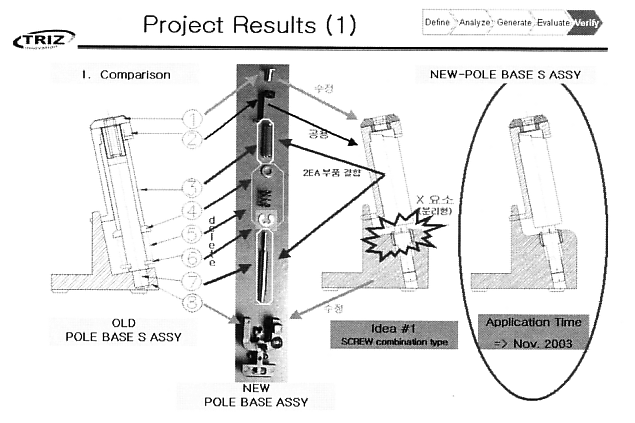
Presentation by Hongyul Yoon et al. (TRIZ Korea, Inc., Korea) [22] also reports an industrial case study, "Cooling problem of wire rod in the manufacturing process". In the manufacturing process, the wire rod is extended to make thinner in a few steps. In the process improvement project, there was a problem of how to control the rod cooling rate. In general, if the rod is cooled slowly we get thicker rod with lower tensile strength, whereas if it is cooled rapidly we get thinner rod with higher tensile strength. But the new requirement of the problem is to manufacture thin rod with low tensile strength. The authors derived a physical contradiction and applied the Separation Principle in Space. The concept found for the solution was to heat the rod in the cooling process only near the surface so as to reduce the temperature diffence between the surface and the body. Induction heating was applied to perform this function.
Paper by Madhav Phadke (Phadke Associates, USA) and Larry Smith (Ford Mortors Co., USA) [15], though not presented at the Conference, is an interesting report on the importance of using Robust Design to solve a technical problem in combination with TRIZ. The problem is an unexpected instable phenomenon in the rotation speed of a diesel engine. When this occurs, the rotation speed of the engin makes a slow oscillation (e.g. 5 Hz) under steady pedal postion ('ringing') or cruise control conditions ('hitching'), and consequently the vehicle makes an unexpected bucking or surging. This phenomenon was relatively rare and difficult to reproduce, but had been a serious reliability problem causing 12 repairs/1000 for many years. TRIZ-AFD was applied to this problem to derive seven different hypostheses as reported in TRIZCON2000. A project team tackled this problem again recently and made a focus on one probable cause, i.e. instability in the controlling software/hardware system. A vehicle was instrumented and the conditon was observed with experiments. On the basis of the analysis of the object system, six control parameters were chosen and set in an L18 experiment of the Robust design. Optimum conditons were extracted from the experiment and were proven by a confirmation experiment. As the result, the hitching/ringing problem was eliminated. The authors conclude: "Robust Design provides fastest, cheapest, and most effective solutions for making software/hardware system designs robust."
Presentation by Monica Bumaz and Noel Leon (ITESM, Mexico) [13] talked about a historical/statistical analysis of patterns of evolution, by taking the pen as an example. In the sense of technology, the pen evolved to the fountain pen and then to the ball-point pen. Ball-point pen was invented in 1925, improved until around 1940, and further refined in minor aspects untill around 1980. Evolution afterwards has been done mostly in industrial designs and in aesthetic aspects. This paper seems to have much interests in numerical data to be compared with Altshuller's results.
Paper by Zhao Xinjun (Northeastern Unversity, P.R. China) [5] reports on the historical evolution of stripping harvesting technology. The description is instructive and enjoyable to read. The evolution is summarized in the following manner:
No tool: farmer, hand pick up. -- pick up the ears(D) Application of TRIZ to Buisness, Management, and Human Problems
Thresher: hand held and threshing -- cut the stalk, carry it, and thresh it.
Combine harvester: all harvesting -- cut and all stalk into harvester
Semi-harvester: semi-harvesting -- cut and upper into harvester
Silsoe stripper: stripping harvesting -- only ears be threshed
Jiang's stripper: stripping harvesting integrated with air suction
... future
Application of TRIZ outside technology has been an important topic in the TRIZ conferences for these years. This year we had four papers/presentations of high quality:
Presentation by Rod Kuhn King (Ideal-Solutions Management Consultancy, USA) [5] reported an intensive framework of analyzing and solving problems in the business/management area. For the purpose of strategic planning of a business, SWOT analysis is a popular technique, where Strengths and Weaknesses at the present and Opportunities and Threats in the future are discussed. The author enhances the SWOT framework much more with the concepts of TRIZ. His "SWOT-Radar Screen" has three levels for representing supersystem (external resources), system (internal resources, mostly intangibles), and subsystem (internal resources, mostly tangibles). For each level, various aspects are itemized with which users are requested to see and describe the SWOTs. This gives a nice framework to describe the business situations by overviewing from a wide range of aspects. Problems and contradictions can be derived from such descriptions. The derived problems may also be schematically plotted in "Bipolar Conflict Graph", where the current and possible future situations may be plotted in the plane of a desirable parameter vs. an undesirable parameter. Since this graph can express contradictory situations of Technical/Physical Contradiction type, possible solutions may be suggested in terms of Inventive Principles and Separation Principles. Usage of this framework is demonstrated with a detailed exemplar analysis of the case of Microsoft company. This case study is very interesting but its document sheets are too extensive and intensive to show in this review, unfortunately.
Presentation by Joe Miller (Quality Process Consulting, USA) [27] is unique to report his application of TRIZ to a community revitalization project. The project is for revitalizing the downtown of a small community called Lake Zurich, Illinois, where the author lives. The author has been actively involved in this project as the current President of "The Lake Zurich Revitalization Partnership". The paper describes the situations of the project, from the aspects of historical background, financial situations, visions, actors involved, plans, problems, etc. The author has been applying TRIZ and Systems Dynamics Modeling to the project for establishing feasible and convincing plans. The diagram below (Fig. 5 of [27]) shows the relationships among actors and events. The right-most two columns show two alternate pathways for the project consequence, i.e. either success or failure. Since financing is the most critical issue in this kind of project, the author uses dynamical models and simulations.
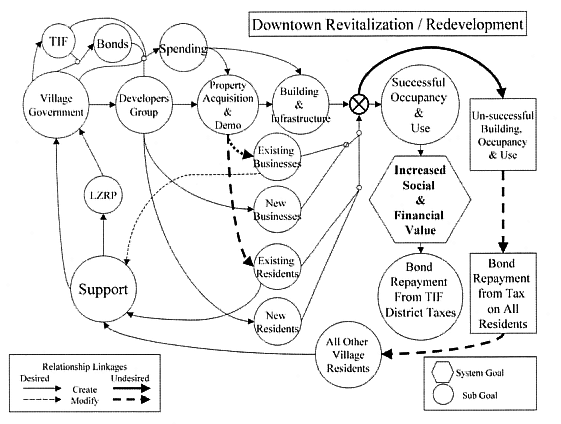
Presentation by Graham Rawlinson (UK) [1] was interesting, but somewhat not easy to read, with deep philosophical/psychological implication in the title of "TRIZ Thinking about Thinking about Thinking". The author explains various levels of thinking and reflection in a general exemplar case:
Worker doing routine tasks (such as washing): necessary to think (about doing, what/how/why/etc.)For training this kind of ability of deeper and reflective thinking, concepts of TRIZ are useful: Concepts of supersystem/syste/subsystem, ideality, contradictions, etc. are all essential. As a practical method of such training in thinking, the author proposes a role play in a workshop:
Supervisor of the worker: necessary to think about how the worker is thinking
Manager of the supervisors and workers: necessary to think one level higher
Leader in the management: necessary to think one more level higher
Role 1: A client: Try to get what you want as much as possible.Paper by Darrell Mann (CREAX, UK) [7] is also an interesting work to handle problems relatd with people; the title is "Perceptions and Intangibles: TRIZ and 'People' Problems". This paper seems to reflect (and probalby further extend) the author's new book (to be published soon) "Hands-On Systematic Innovation for Business and Management". The author says: TRIZ which was originated in technology field is still weak to solve problems related to 'people', where the issues of perceptions and intangibles are critical. Thus he proposes a framework for tackling 'people' problems, by taking 'Motivation Problem'as a example in the following way:
Role 2: A professional: Try to gain as much acceptance as possible in a situation contradictory to the client's direct desire.
Role 3: Mirror Person: Help people reflect what they are doing/saying (by stopping the two persons' dialog every 2 minutes)
Role 4: Mirror Person Level 4: Help Mirror Person Level 3 refect on what they did/said.
All the audience: Try to see what is happening through all the levels.
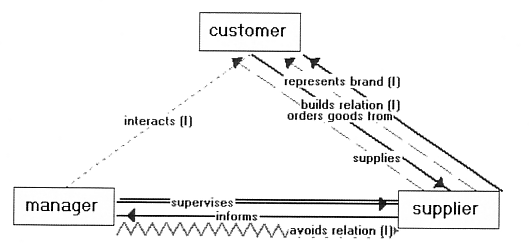
Various perceptions by the problem solving team should be analysed openly, the author says. So another tool of "Perception Mapping" is also demonstrated. Posing the question in the form "People don't motivate themselves (at work) because:- ", a considerable number of answers (i.e. perceptions) of people are collected and the cause-effect relationships among them are constructed to be shown in the "Perception Map". This kind of map appears to be useful to reveal and understand intangible relationships and perceptions among the actors in the system (and among the project members).
Miscellaneous /
Concluding
Remarks
On the
afternoon of April 26, TRIZCON2004
tour to BOEING's
assembly plant in Everett, WA was held. More
than
half of the
conference participants apparently joined the bus tour (combined with a
winery tour on its return trip), but the present author could not
because he was presenting a paper at that time.
In the
Closing Session of the
Conference, Larry Smith (President of
Altshuller Institute) led a summary session of remarks from the
participants with the title of 'Liked' and then 'Would like'.
Many people pointed out 'success stories in industries' as the most
important outcome of the conference this year. The issue of
parallel tracks and the length of each presentation was also discussed
.
List
of Papers in the Proceedings and Other Presentations
Note: --:
Published but not presented, --&: Not published but
presented with a handout,
--#: Not published but presented with no handout.
[1] - [30]: Paper number in the Proceedings (there are some
missing
numbers), [31] - [35]: Tentative numbering of the
presentations.
Presentors at the conference are shown in the boldface below.
[A]
Keynote Speech:
TRIZ and Innovation at BAE Systems
--#
Pauline Marsh
(BAE Systems, UK)
[B] Panel Discussion:
"The Implementation of TRIZ in the Corporate World"
--#
Jack Hipple
(Innovation-TRIZ,
USA) (Coordinator); Larry Smith
(Ford Motor Co.), Adam Brostow
(Air Products), Doug Gundlach
(S.C. Jphnson), Kiho Sohn
(Boeing), John
Spitznagel (Siemens)
[1]
TRIZ Thinking
about Thinking about Thinking
Graham
Rawlinson
( , UK)
[2] Using Axiomatic
Design to Integrate Comprehensive
QFD and TRIZ in Design for Six Sigma
Michael S.
Slocum (Breakthrough
Management Group, USA) and Ellen
Domb
(PQR Group, USA)
[3] TRIZ in SAMSUNG
R&D
Process
[ -- Abstract only ]
Mi Jeong Song, Vassili
Leniachine, and Se Ho Cheong (Samsung Advanced Institute
of Technology, Korea)
[4] Enhancing SWOT
Analysis Using TRIZ and
the Bipolar Conflict Graph: A Case Study on the Microsoft Corporation
Rod
Kuhn King (Ideal-Solutions
Management Consultancy, USA)
[5] Analyze and Research
on the Evolution
of Stripping Harvesting Tecdhnology
--
Zhao Xinjun (Northeastern
University, P.R. China)
[7] Perceptions and
Intangibles. TRIZ
and 'People' Problems
--
Darrell Mann (CREAX, UK)
[10] Levels of Invention
and Intellectual
Property Strategies
Boris Zlotin and Alla Zusman
(Ideation International, USA)
[13] Pattern of
Evolution and Industrial
Design: The Pen
Monica Bumaz and Noel Leon
(Monterrey Technical University,
Mexico)
[15] Optimization of a
Diesel Engine Software
Control Strategy
--
Madhav S. Phadke (Phadke
Associates, USA) and Larry R.
Smith (Ford
Motor
Co., USA)
[16] Accelerated
Adoption -- Strategies
for Generating Maximum TRIZ Benefit in Minimum Time
--
Prakash R. Apte and S. A. Soman
(India Institute of Technology, Bombay,
India), and Darrell L. Mann
(CREAX, UK)
[17] Practices of
Applying TRIZ/USIT in Japan
Toru Nakagawa
(Osaka Gakuin
University, Japan)
[Reposted in the "TRIZ Home Page in
Japan", May 13, 2004 ]
[19] Process Modeling,
Simulation, and TRIZ:
An Innovative and Symbiotic Solution
Charles Sorgie
(iGrafx, USA)
[Reposted in the "TRIZ Journal", May
1, 2004]
[22] Case Study: A
Cooling Problem
of Wire Rod Manufacture
Hongyul Yoon, Marino Kim (TRIZ
Korea, Inc., Korea) and Chulmin
Bae (POSCO,
Korea)
[24] Innovation in the
Material Cost of 8
mm Camcorder Using TRIZ
Young-Ho Cho
(SAMSUNG
Electronics, Korea)
[25] TRIZ Activities in
SAMSUNG Electronics
Sung-Wook Kang, Jeong-Seon Kim,
Jun-Young Lee, Valery Krasnoslobodtsev,
and Georgy Severinets (SAMSUNG Electronics, Korea)
[27] TRIZ Solutions for
Systems Dynamics
Models of a Small Community Downtown Revitalization Project
Joe A. Miller (Quality
Process
Consulting, USA)
[Reposted in the "TRIZ Journal", May
1, 2004]
[29] TRIZ and Artificial
Intelligent Software
in the Conceptual Design
Ahto Klja, Tiit Tiidemann
(Tallinn Technical University, Estonia)
[30] Semantic TRIZ
Mikhail Verbitsky
(Invention Machine Corp., USA) [presented
by James
Todhunter (Invention
Machine Corp., USA)]
[31] TRIZ++ as a
Professional Consulting
Methodology: Case Studies
--&
Simon Litvin
(GEN3 Partners,
USA)
[32] TRIZ through the
Eyes of the Chief Technology
Officer
--#
Peter Hanik, David Bonner
(Ideation International Inc., USA)
[33] Strategies for
Patent Busting Using
Function Analyis and TRIZ
--&
Sergei
Ikovenko (GEN3
Partners, USA)
[34] TRIZ Management
Problems Solved at BAE
Systems
--&
Karen
Gadd (Oxford Creativity,
UK) and Pauline Marsh
(BAE Systems, UK)
[35] TRIZ and Future
Vision
--#
Boris Zlotin and Alla Zusman
(Ideation International, Inc., USA)
Last updated on May 19, 2004. Access point: Editor: nakagawa@utc.osaka-gu.ac.jp